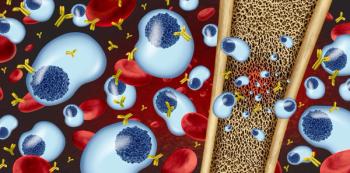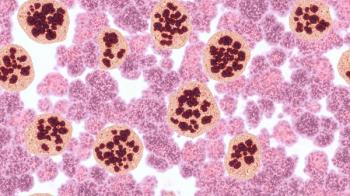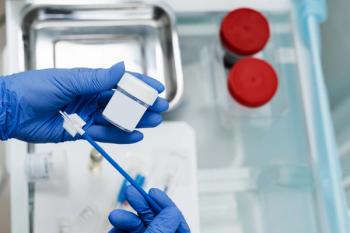Précis
Critically ill patients treated with a pharmacist-managed insulin protocol achieved higher rates of glucose control than those treated with conventional methods.
Abstract
Objectives
Previous studies evaluating a pharmacist-managed insulin protocol in high-risk patients have shown a faster time to glucose control compared with standard insulin management, but these studies have not evaluated such a protocol in addition to collaborating with diabetes coordinators (ie, registered nurses who specialize in diabetes management). The purpose of this study was to compare outcomes pre- and post implementation of an intensive care unit (ICU) pharmacist–managed insulin protocol in collaboration with diabetes coordinators. The primary outcome was sustained blood glucose (BG) control, and the main secondary outcome was time to BG control.
Study Design
Single-center, pre-/postintervention study conducted in 2 medical ICUs (MICUs) within Moses H. Cone Memorial Hospital.
Methods
Patients were included if they were admitted to 1 of the 2 MICUs for at least 24 hours with 2 or more capillary BG readings greater than 180 mg/dL in a 24-hour period and were receiving enteral nutrition. MICU pharmacists evaluated patients’ capillary BG daily and adjusted sliding-scale insulin, basal insulin, and/or insulin for tube feeding (administered every 4 hours) until patients transferred off the critical care service or tube feeds were discontinued. Diabetes coordinators wrote daily recommendations to assist with insulin adjustments. A preintervention population served as the control.
Results
This study included 111 patients—79 in the preintervention group and 32 in the postintervention group. The percentage of patients who attained BG control (defined as at least 3 consecutive capillary BG readings of 100-180 mg/dL in 24 hours) in the preintervention group was 74.7% and 93.8% in the postintervention group (risk ratio, 1.26; 95% CI, 1.07-1.47; P = .023). For the secondary outcome of time to BG control, the median (IQR) was 39.9 (24.0-81.3) hours in the preintervention group and 30.8 (16.8-41.2) hours in the postintervention group (P = .001).
Conclusion
Pharmacist-managed insulin therapy in the MICU in collaboration with inpatient diabetes coordinators resulted in a higher percentage of patients attaining BG control in a shorter amount of time compared with the preintervention group.
Introduction
Achieving and maintaining glucose control in patients in the intensive care unit (ICU) continues to be a significant challenge, and poor control can lead to a range of serious health complications and even death.1-3 Hyperglycemia is associated with an increased incidence of hospital-acquired infection and acute kidney injury, increased duration of ICU admission, increased time on mechanical ventilation, and increased mortality.1,2 Alternatively, hypoglycemia increases the risk of cardiac arrhythmias, seizure, irreversible brain damage, and death.3 The NICESUGAR trial (NCT00220987) evaluated intense glycemic control (ie, blood glucose [BG] target 81-108 mg/dL) vs conventional glycemic control (ie, BG target ≤ 180 mg/dL) in critically ill patients in a medical ICU (MICU) or surgical ICU.4 The results of this trial suggested that intense glycemic control led to more deaths compared with conventional control due to increased rates of hypoglycemia.4 Consequently, the American Diabetes Association recommends a BG goal of 140 to 180 mg/dL in critically ill patients.5
Several studies have evaluated the use of a pharmacist-managed glycemic control protocol in the ICU setting to determine whether its use results in greater glucose control among critically ill patients.6,7 One pre-/postintervention study saw a significant reduction (–1.5 events per 1000; 95% CI, –1.54 to –1.48; P < .001) in severe hypoglycemic events (ie, BG ≤ 40 mg/dL) in hospitalized patients with diabetes after protocol implementation.6 Another study found that 47% of patients attained BG control (ie, BG of 70-150 mg/dL) within 48 hours of protocol initiation.7 There is, however, a lack of data evaluating the use of these protocols in collaboration with other health care professionals, such as registered nurses who specialize in diabetes management (hereafter, diabetes coordinators).
This single-center, pre-/postintervention study sought to determine whether a pharmacist-managed insulin protocol in collaboration with inpatient diabetes coordinators resulted in an increased rate of glucose control among patients in the MICU.
Materials and Methods
Design/Setting
This single-center, pre-/postintervention study occurred at the Moses H. Cone Memorial Hospital, a large community medical center. It was deemed exempt research under Category 4 (ie, secondary research uses of identifiable private information or identifiable biospecimens) by the Cone Health Institutional Review Board (IRB). Our intervention was aimed at quality improvement and aligned with previous descriptions in the literature of pharmacist-managed glycemic control protocols in the ICU setting that reduced the incidence of severe hypoglycemic events and promoted timely achievement of BG control.6,7 The intervention included the additional quality improvement component of collaborating with other health care professionals; in this case, diabetes coordinators. The project also involved a research component: collection of data from the electronic medical record. We were required to describe in detail for the IRB the steps planned for keeping protected health information secure. We also requested and received a waiver of informed consent and a Health Insurance Portability and Accountability Act waiver as part of our IRB application. Included patients were admitted to 1 of the 2 MICUs, with a combined capacity of 28 beds. Each MICU had a dedicated pharmacist on weekdays and 1 shared pharmacist on weekends. Multiple diabetes coordinators rotated between the units on weekdays and weekends. Diabetes coordinators were registered nurses within the Cone Health system who specialize in diabetes management. Once consulted in the hospital, they provide daily recommendations for insulin management in patients with uncontrolled glucose levels.
Participants
From July 1, 2022, to February 16, 2024, we screened 245 patients for eligibility. Of these, 79 patients were included in the preintervention group and 32 in the postintervention group (Figure 1). Patients were included if they were admitted to 1 of the 2 MICUs for at least 24 hours with 2 or more capillary BG readings greater than 180 mg/dL in a 24-hour period and were receiving enteral nutrition (ie, tube feeding). Patients were excluded if they were pregnant, were receiving intravenous (IV) insulin or total parenteral nutrition, had an active diagnosis of diabetic ketoacidosis, or had a diagnosis of end-stage renal disease on hemodialysis.
Study Protocols
During daily rounds, MICU pharmacists identified patients with at least 2 capillary BG readings greater than 180 mg/dL in the previous 24 hours. If a patient met these criteria, the pharmacist would discuss with the provider whether it was appropriate for pharmacy to manage the patient’s glucose control. If acceptable, the provider would order the “pharmacy to dose insulin” consult to formally include the pharmacist in the management of the patient’s BG. These consults took place during daily rounds with the attending provider, not after hours. Retrospectively, investigators screened patients with a pharmacy to dose insulin consult for inclusion in the study evaluation.
As part of routine care in the MICU, nursing staff obtained capillary BG values every 4 hours. The ideal BG range for this study was 140 to 180 mg/dL; however, BG values from 100 to 180 mg/dL were considered acceptable. Typically, reductions in insulin dosage did not occur in patients with a BG level of 100 to 140 mg/dL. MICU pharmacists monitored BG values and collaborated with diabetes coordinators to appropriately initiate and adjust patients’ insulin regimens each morning. Insulin regimens included basal insulin, sliding-scale insulin, and tube-feed insulin coverage (administered every 4 hours). When patients had orders for both sliding-scale and tube-feed insulin, a nurse would obtain a capillary BG sample prior to administration. Based on the result, the sliding-scale dose would be added to the scheduled tube-feed insulin in the same syringe. In the event of a BG value less than 70 mg/dL, nurses were authorized to administer 25 g of a 50% dextrose IV solution to the patient.
Diabetes coordinators would leave a daily chart note with their recommendations for insulin adjustments and frequently reach out to the MICU pharmacists for further discussion regarding insulin management. Ultimately, adjusting insulin regimens was at the discretion of the MICU pharmacist. Following any insulin regimen adjustments, MICU pharmacists would document their interventions in a daily progress and intervention note within each patient’s electronic health record.
Intervention
Preintervention data were collected from July 2022 through January 2023. Regarding glucose management, patients in the preintervention group were treated with conventional methods, primarily physician-led management with or without input from diabetes coordinators or pharmacists. Postintervention data were collected from August 1, 2023, through February 16, 2024. Patients in the postintervention group were treated with the pharmacist-managed insulin protocol in collaboration with diabetes coordinators.
Outcome Measures
The primary outcome was sustained BG control, defined as at least 3 capillary BG readings of 100 to 180 mg/dL in a 24-hour period. The main secondary outcome was time to BG control. Other secondary outcomes included percentage of BG levels from 140 to 180 mg/dL and 100 to 180 mg/dL after initial BG control was achieved, MICU length of stay, time on mechanical ventilation, incidence of acute kidney injury, and transition rate from subcutaneous (SQ) to IV insulin. Safety outcomes included pre–hypoglycemic events and hypoglycemic events (BG level of 70-100 mg/dL and < 70 mg/dL, respectively) and the need for treatment of hypoglycemic events.
Analyses
To achieve 80% power at a 1-sided α level of .05, a total of 50 patients were required in each group. All outcomes followed intention-to-treat principles. We calculated the primary outcome (percentage of patients achieving BG control) using the χ2 test. The main secondary outcome (time to BG control) was calculated using a log-rank test. We used the Wilcoxon rank sum test to evaluate all other secondary outcomes except the incidence of acute kidney injury and the rate of treatment for hypoglycemic events, for which we employed the χ2 test. All analyses were performed with Stata 15.1 (StataCorp LLC).
Results
Sample Characteristics
The characteristics of the patients (Table 1) were evenly distributed between groups, except for vasopressor use greater than 24 hours (41.8% in the preintervention group vs 78.1% in the postintervention group; P = .001). At screening, 59.5% of patients in the preintervention group and 75.0% of patients in the postintervention group had a diagnosis of diabetes mellitus, with a mean hemoglobin A1C level of 7.2%. Additionally, 53.2% of patients in the preintervention group and 43.8% in the postintervention group received systemic corticosteroids.
Outcomes
The primary outcome of sustained BG control occurred in 59 patients (74.7%) in the preintervention group and 30 patients (93.8%) in the postintervention group (risk ratio, 1.26; 95% CI, 1.07-1.47; P = .023) (Table 2). For the main secondary outcome of time to BG control, the median (IQR) was 39.9 (24.0-81.3) hours in the preintervention group and 30.8 (16.8-41.2) hours in the postintervention group (P = .001) (Table 2; Figure 2).
The mean (SD) percentage of BG levels within 140 to 180 mg/dL after obtaining initial BG control was slightly lower in the preintervention group at 32.6% (19.2%) vs the postintervention group at 33.1% (26.5%) (P = .748), whereas the mean (SD) percentage of BG levels from 100 to 180 mg/dL after obtaining initial BG control was slightly higher in the preintervention group at 72.1% (21.7%) vs the postintervention group at 68.8% (27.6%) (P = .869) (Table 2). Although the median (IQR) MICU length of stay was shorter in the preintervention group than the postintervention group (7.7 days [3.8-11.6] vs 8.5 days [6.2-12.8], respectively; P = .082), it was not statistically significant (Table 2).
In regard to insulin regimens, 96.2% of patients in the preintervention group were receiving sliding-scale insulin vs 100% of patients in the postintervention group; 40.5% of patients were receiving basal insulin in the preintervention group vs 68.8% in the postintervention group; and 22.8% of patients were receiving tube-feed coverage (in addition to sliding-scale insulin) in the preintervention group vs 59.4% in the postintervention group. Rate of transition from SQ to IV insulin was studied only in the postintervention group, with 15.6% of patients requiring transition to IV insulin.
Safety
Incidence of hypoglycemic events were categorized into 2 groups: pre–hypoglycemic events (BG level = 70-100 mg/dL) and hypoglycemic events (BG < 70 mg/dL) (Table 3). For BG levels between 70 and 100 mg/dL, a mean of 3.8 pre–hypoglycemic events occurred per patient in the preintervention group vs 3.2 in the postintervention group (P = .555). For BG levels less than 70 mg/dL, a per-patient mean of 0.58 and 0.78 hypoglycemic events occurred in the pre- and postintervention groups, respectively (P = .356). Approximately 22.8% of patients in the preintervention group received hypoglycemic treatment compared with 28.1% in the postintervention group (P = .553).
Discussion
In this single-center, pre-/postintervention study involving patients admitted to the MICU with uncontrolled BG and on tube feeds, the primary outcome of sustained BG control occurred significantly more in the postintervention group than in the preintervention group. Patients in the postintervention group also achieved glucose control significantly faster than patients in the preintervention group. These results could be attributed to more patients in the postintervention group receiving basal and tube-feed insulin or simply to pharmacist and diabetes coordinator recommendations and collaboration. Diabetes coordinators made insulin-adjustment recommendations via chart notes for the pre- and postintervention groups, but pharmacists were not consulted to manage patients’ insulin regimens in the preintervention group. Consequently, diabetes coordinators and pharmacists collaborating to adjust insulin may have resulted in higher rates of sustained BG control in the postintervention group. Pharmacy to dose protocols are common within our institution, so the addition of this new consult did not significantly alter the pharmacist’s workload. Although more patients in the postintervention group attained BG control, the percentages of BG levels from 140 to 180 mg/dL (ideal BG range) and 100 to 180 mg/dL (acceptable BG range) after achieving initial control were similar. This could be due to higher rates of hypoglycemic events (ie, BG < 70 mg/dL) in the postintervention group than in the preintervention group. Additionally, the longer median MICU length of stay in the postintervention group may not necessarily be directly related to insulin management because these are complex patients with many health problems and varying levels of acuity.
Our study findings differ from prior studies, which showed a significant reduction in the frequency of severe hypoglycemic events after implementation of a pharmacist-managed insulin management protocol.6,7 The Cook et al study found that severe hypoglycemic events (ie, BG ≤ 40 mg/dL) decreased by 1.5 events per 1000 hospitalized patients with diabetes after protocol implementation (95% CI, –1.54 to –1.48; P < .001),6 and the Gerhardt et al study showed that the pharmacist-managed insulin protocol group had low rates of hypoglycemia (1% with BG < 70 mg/dL) and no patients with severe hypoglycemia (ie, BG < 40 mg/dL).7 The increased insulin usage in our postintervention group and the inability to capture pauses in tube feeds could explain the higher incidence of hypoglycemic events (ie, BG < 70mg/dL) in our postintervention group. The results of this study do, however, align with findings from the Hadiprodjo et al study, which showed that a significantly higher percentage of patients attained normoglycemia (ie, BG 70-180 mg/dL) after implementation of a pharmacist-managed glycemic control protocol (63.4% vs 50.2% preimplementation; P < .01).8
Although other studies have evaluated pharmacist collaboration with hospitalists regarding insulin management, none have studied collaboration between pharmacists and diabetes coordinators. Additionally, MICU pharmacists in this study were able to adjust insulin regimens independently without having to first consult with a physician or merely recommend changes to a physician.
About the Authors
Sydney K. Davis, PharmD, is an acute care pharmacist at Cone Health Wesley Long Hospital in Greensboro, North Carolina.
Michael A. Maccia, PharmD, BCCCP, is a pharmacy coordinator for research and education at Moses H. Cone Memorial Hospital in Greensboro, North Carolina.
Kinsey M. Johannemann, PharmD, BCPS, is an infectious diseases clinical pharmacist at Piedmont Medical Center in Rock Hill, South Carolina.
Eden E. Brewington, PharmD, BCCCP, is a critical care clinical pharmacist at UK HealthCare in Lexington, Kentucky.
Daniel C. Smith, MD, is a critical care medicine specialist at Cone Health LeBauer HealthCare in Greensboro, North Carolina.
Limitations
This study has several limitations. The small sample size in both arms (79 patients in the preintervention group and 32 patients in the postintervention group) limits the ability for results to be generalized to other populations, such as patients with type 1 diabetes or prediabetes and Black, Asian, and Hispanic patients. In addition, because a power calculation was not performed for the secondary outcomes, it is likely that the smaller population reduced our ability to detect a statistical difference (ie, type II error), limiting interpretation of secondary outcome results. Also, the primary outcome of sustained BG control was defined as at least 3 capillary BG readings of 100 to 180 mg/dL in a 24-hour period, and is not a validated measure, but rather, a definition created by the investigators of this study. Moreover, a lack of patient blinding may have produced pharmacist performance and/or reporting bias between the pre- and postintervention groups. Lastly, BG levels may not have been evaluated over the entirety of the patients’ MICU stay because data collection occurred only for the period that a pharmacy to dose insulin consult was active. Reasons a consult may have been discontinued prior to MICU discharge include discontinuing tube feeding, initiating hemodialysis, or initiating total parenteral nutrition.
Conclusions
Because of a lack of data evaluating the use of a pharmacist-managed insulin protocol within a collaborative health care framework, we sought to determine whether such a protocol in the MICU in collaboration with inpatient diabetes coordinators would result in an increased rate of glucose control in high-risk patients. This single-center, pre-/postintervention study found that among patients in the MICU with uncontrolled BG and tube feeds, those treated with the pharmacist-managed insulin protocol (ie, the postintervention group) had a higher rate of achieving glucose control in a shorter amount of time than those treated with conventional methods (ie, the preintervention group).
The higher success rate of achieving BG control in the postintervention group is likely due to pharmacists’ specialized knowledge of managing insulin dosages and the collaborative approach that leveraged the unique experience of both pharmacists and diabetes coordinators, resulting in a more comprehensive, individualized approach to care. Our study findings highlight the effectiveness of pharmacist-led insulin management in the MICU setting and emphasize the importance of a multidisciplinary approach to diabetes management.
REFERENCES
1. Van den Berghe G, Wilmer A, Hermans G, et al. Intensive insulin therapy in the medical ICU. N Engl J Med. 2006;354(5):449-461. doi:10.1056/NEJMoa052521
2. Yao RQ, Ren C, Wu GS, Zhu YB, Xia ZF, Yao YM. Is intensive glucose control bad for critically ill patients? a systematic review and meta-analysis. Int J Biol Sci. 2020;16(9):1658-1675. doi:10.7150/ijbs.43447
3. Egi M, Bellomo R, Stachowski E, et al. Hypoglycemia and outcome in critically ill patients. Mayo Clin Proc. 2010;85(3):217-224. doi:10.4065/mcp.2009.0394
4. Finfer S, Chittock DR, Su SY, et al; NICE-SUGAR Study Investigators. Intensive versus conventional glucose control in critically ill patients. N Engl J Med. 2009;360(13):1283-1297. doi:10.1056/NEJMoa0810625
5. American Diabetes Association. Standards of Medical Care in Diabetes-2022 abridged for primary care providers. Clin Diabetes. 2022;40(1):10-38. doi:10.2337/cd22-as01
6. Cook CA, Vakayil V, Pribyl K, et al. A pharmacist-driven glycemic control protocol to reduce the rate of severe hypoglycemia in high-risk patients. Hosp Pharm. 2022;57(1):45-51. doi:10.1177/0018578720973891
7. Gerhardt JM, Dine SA, Foster DR, et al. Development of a pharmacist-managed protocol for the transition from intravenous to subcutaneous insulin in critically ill adults. Am J Health Syst Pharm. 2022;79(suppl 3):S86-S93. doi:10.1093/ajhp/zxac141
8. Hadiprodjo AG, Scott EM, Weng R. 1019-P: implementation analysis of pharmacist-managed insulin dosing in an acute care hospital. Diabetes. 2023;72(suppl 1):1019-P. doi:10.2337/db23-1019-P





















































































































































































































